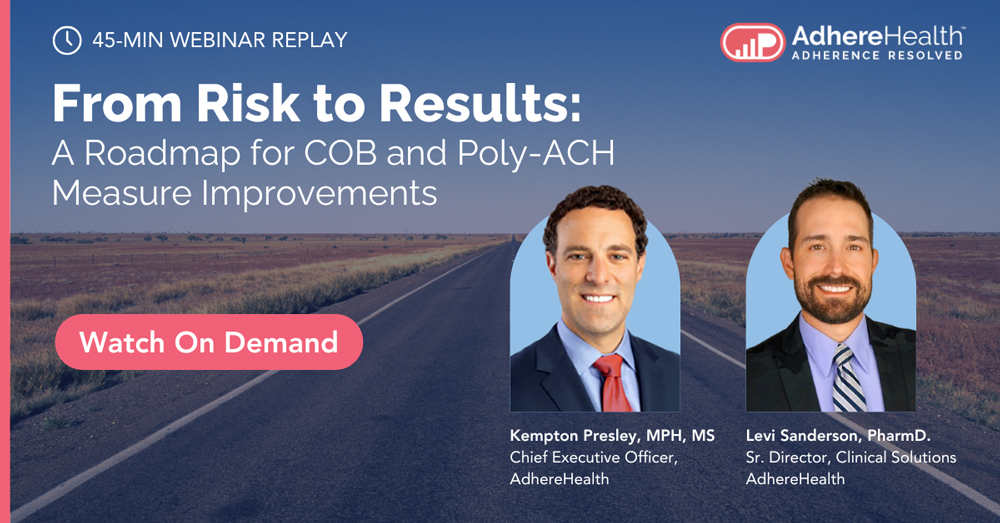Published on .
Imagine being elderly, juggling prescriptions from three different specialists, and trying to remember whether the blue pill should be taken before or after breakfast. For millions of Medicare-age adults, this isn’t hypothetical—it’s daily life.
Older adults face a dual challenge: complex medical needs combined with social and behavioral barriers that threaten adherence with condition-sustaining medications. One missed refill can snowball into a hospitalization, a fall or even the loss of independence. These are costly setbacks in value-based care, as well as patient safety concerns.
Care navigators and outreach clinicians help close this gap. With the right training, tools and data, these valuable team members address clinical needs and resolve real-world challenges—improving health outcomes while strengthening Star Ratings.
Juggling Pills, Providers and Risks
Nearly three-quarters of adults over 65 live with at least one chronic condition, and more than half manage two or more simultaneously. That complexity often necessitates multiple prescriptions—on average, four to five medications daily—creating polypharmacy risks like duplication, confusion and harmful interactions.
In older adults, high-risk drugs such as opioids, benzodiazepines and anticholinergics frequently lead to falls, cognitive decline or hospitalization. Add in the reality that many seniors see multiple providers, fragmented care becomes another hurdle. Conflicting instructions or inconsistent monitoring can quickly disrupt adherence.
When Life Gets in the Way of Adherence
Clinical complexity is only half the story. Everyday barriers like transportation, finances and isolation often determine whether a member stays on track. Nearly one in five older adults no longer drives, turning a pharmacy trip into a major ordeal. Copays and coinsurance strain limited budgets, and 71% of adults over 60 struggle with health literacy, making it difficult to interpret instructions or evaluate options.
Behavioral hurdles add another layer. Forgetfulness, depression or denial of illness often lead to skipped doses. And for members living alone without strong support systems, the likelihood of drifting away from adherence only increases.
The Human Link Between Prescriptions and Real Life
This is where care navigators change the story. They provide advice to simplify medication schedules, help translate medical jargon into plain language and arrange mail-order prescriptions or transportation to eliminate access barriers.
Equally important, care navigators provide the human connection many older adults lack. Through empathetic, consistent outreach they build trust, reduce loneliness and encourage engagement. They can help ease financial strain by helping members navigate health plan benefits or explore prescription assistance programs. To help adherence stick, care navigators often use simple behavioral nudges to reinforce routines and memory.
Take “Mrs. Johnson,” age 78. When her copay for a diabetes medication jumped from $10 to $40, she quietly stopped filling her prescription. During a routine call, an AdhereHealth Care Navigator uncovered the issue and helped her switch to a covered generic—restoring adherence before her condition could spiral out of control.
At the system level, care navigators help align prescribers, pharmacists and specialists to reduce fragmentation. They also surface hidden issues like food insecurity or caregiver stress before these can escalate into crises. This blend of clinical insight, problem-solving and compassion makes these outreach specialists uniquely effective at helping Medicare-age adults stay adherent.
A Checklist for Empowering ACNs
Care navigators are most effective when supported with the right infrastructure. AdhereHealth equips our own Adherence Care Navigators, or ACNs, with advanced data analytics, omnichannel outreach tools and behavioral science training to deliver measurable results. For health plans, the path forward can be thought of as a checklist for action:
☐ Leverage data analytics to identify and prioritize high-risk members. Predictive models surface those most likely to become nonadherent so navigators can intervene early, preventing costly events.
☐ Offer omnichannel outreach such as phone, text and other preferred methods. Meeting members on their terms increases engagement and keeps conversations personal.
☐ Centralize intervention tracking to ensure continuity of care and reduce abrasion. A unified platform gives navigators a holistic view of each member’s journey, preventing duplicated outreach and aligning with providers.
☐ Provide behavioral science training in motivational interviewing and nudges. These skills help ACNs uncover hidden barriers, encourage small changes and move members toward lasting adherence.
☐ Integrate resources and community connections to address social determinants of health. From meal delivery to transportation, connecting members with support systems tackles real-life obstacles to adherence.
☐ Continuously monitor outcomes and refine strategies using analytics. Feedback loops sharpen navigator interventions over time, boosting efficiency and ROI.
These action items help ensure outsourced or in-house care navigators have the support needed to address adherence as both a clinical and behavioral journey.
The Bottom Line: Better Adherence, Better Outcomes
Medicare-age adults face overlapping medical, social and behavioral challenges that make adherence difficult—but not impossible. Care navigators, when equipped with the right mix of data, training and tools, bridge the gap between clinical need and everyday reality.
For health plans, the opportunity is clear: equip care navigators to meet the ongoing needs of an aging population. By doing so, plans can turn medication adherence into a sustainable advantage.
When care navigators are empowered, health plans don’t just improve adherence today—they create healthier, more engaged members, lower overall costs and strengthen Star Ratings for long-term success.

Joan Polk
Associate Vice President, Clinical Operations at AdhereHealth

